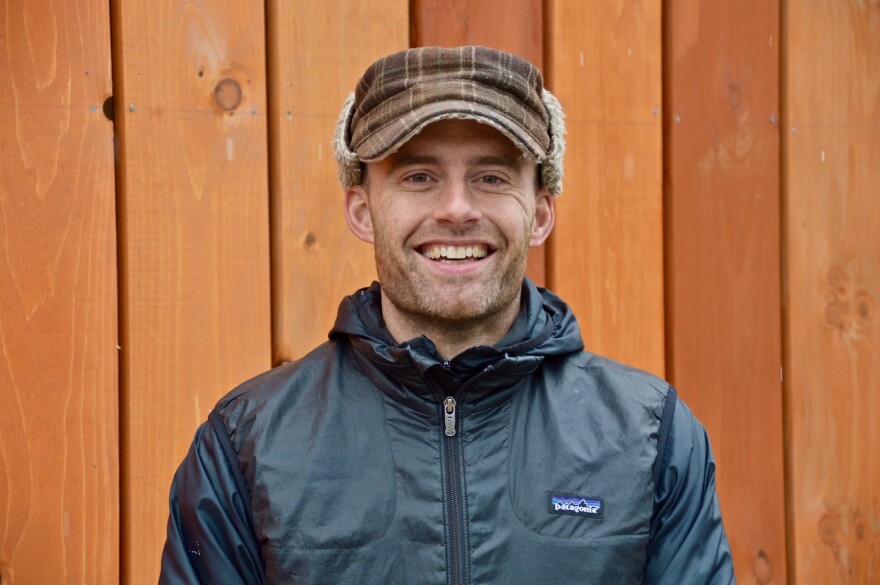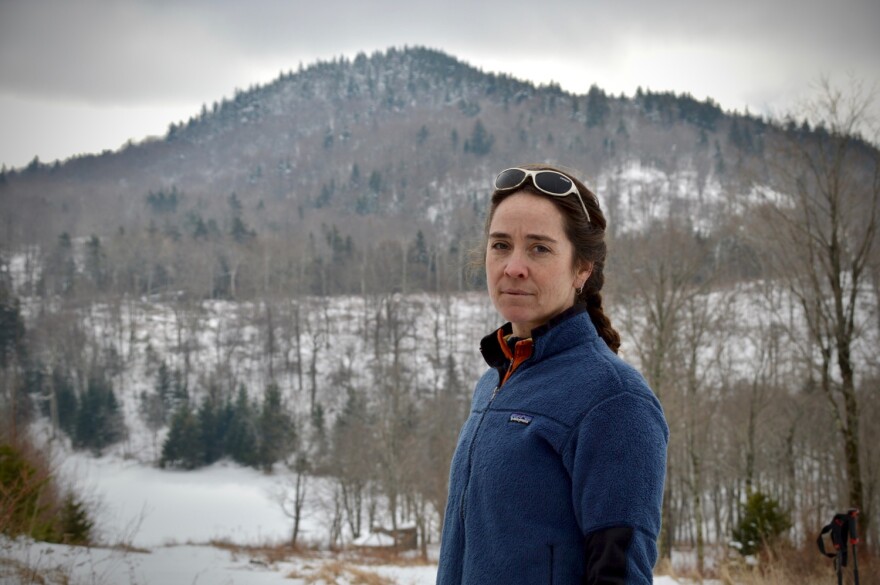Imagine if you could hike, mountain bike or backcountry ski from one end of Vermont to the other — and stay in heated cabins along the trail.
That’s the vision of the Vermont Huts Association, a new nonprofit that wants to make the outdoors more easily accessible.
The organization's website lays out their vision: "923 miles of trails. 32 potential huts. 1 network." RJ Thompson, executive director of Vermont Huts Association, admits they're just getting started.
“There it is; that’s our first hut,” says Thompson, pointing to a 660-square-foot wood cabin that's stained a striking red.

“Yeah, I think it’s gonna look really incredible during foliage season.”
Thompson was showing off the new structure at Yestermorrow Design/Build School in Waitsfield last month. Inside, students were putting the finishing touches on the compact cabin that’ll sleep up to 10 people.
“That’s gonna be the bunk room back there,” he said as he walked carefully around the student builders.
"So you can see they've started doing the drywall in there. They'll be painting it, I think later this afternoon. Over here to your left is the actual entryway. And so there'll be a little mudroom there, with a gear room and some racks for some gear," added Thompson.

Yestermorrow instructor Jesse Cooper said local materials and energy efficiency were key parts of the design.
“Then we visited the site [where the cabin will eventually be located] several times and looked at what was around there and thought a lot about what it would feel like to be there and tried to understand everything about backcountry skiers and mountain bikers and what would be an exciting thing for them to walk into,” explained Cooper.
Basics — like comfortable mattresses, a propane stove and cooktop — were obvious, Cooper said. But he says they also wanted to include some fun surprises, like a corner reading nook that can transition into a cozy sleeping area.
“We thought a lot about the views out the windows, looking down onto these beautiful expanses of stream,” said Cooper. “About locating decks where you would transition from the inside of the house to the outside and then have a nice place to sit in the outside.”
They thought about how visitors would "discover the building, and how the building helps them discover the surrounding environment," Cooper went on.

Thompson says this first hut — which is now finished — cost about $60,000 to design and build, with funding coming from a mix of grants, private donations and membership fees.
Becoming a member of the Vermont Huts Association costs $35 for an individual and $65 for a family of four. So far, Thompson says they have 176 paid members.
The Green Mountain National Forest still has to sign off on the new hut’s final location. But Christopher Mattrick, a district ranger with the Green Mountain and Finger Lakes National Forest, says the proposed site — in the Chittenden Brook Campground, between Rochester and Chittenden — is ideal because there’s already a campsite, and it’s linked to extensive hiking and new backcountry ski trails.
“We want to be strategic about where any proposals are put forward or any structure goes into place, so that it’s not, you know, creating a new recreation area where we have not desired one to be,” said Mattrick. "And we've been working closely with Vermont Huts on that."
If the Chittenden Brook Campground site is approved and all goes according to plan, Mattrick says the new hut will be moved in with trucks in late summer or fall.
Watch an illustrated, virtual tour of the cabin (via Vermont Huts Association):
https://www.youtube.com/watch?v=OuNxA9-B22I&feature=youtu.be
The Vermont Huts Association already promotes several other cabins in the state in the Northeast Kingdom, Bolton Valley and Merck Forest in Rupert, for example.
You can rent them on the association’s website, which lists each hut’s amenities.
Bolton Lodge, for example, costs $75 a night from Monday through Thursday; it's an additional $20 each night on Friday, Saturday and Sunday. Seasoned wood is provided for the wood stove, but bring your own headlamps and this time of year, dress warm — it's not insulated.

Thompson says lots of other shelters do exist in the state and their organization has checked out between 20 and 30 of them. But he says many were either not well connected to trails or were owned privately by people not interested in making them available to the public.
He says because they’re trying to create a network, they’re focusing their initial build-out of new huts between Killington and Stowe, where they've identified about a dozen prospective sites. He says he doesn't anticipate a lot of pushback because the scale of the huts in Vermont will be small— unlike the larger, hotel-style huts in other parts of New England. And he says any huts placed on public land would have to go through an extensive approval process.
"We came together a little over a year ago with the Green Mountain Club, Catamount Trail Association, Vermont Mountain Bike Association," explained Thompson, "and then we also, of course, brought in our friends from [Vermont] Forest, Parks and Rec, and the Green Mountain National Forest to really kind of get our hands on what a hut-to-hut network in Vermont could look like and conceptually begin to visualize, on maps, where we might place these huts based on the existing trail networks that we already have, while also considering the potential for expanded trail networks."

Earlier this month, a small group of backcountry enthusiasts, including Kate Wanner, a project manager with the Trust for Public Land, skinned up to what many had hoped would become the jewel of the Vermont Huts Network — a remote three-bedroom, two-bathroom log home with stunning views of the Chittenden Reservoir and a nearby pond, just a quarter mile from the Long Trail.
Back in December, the Trust purchased this parcel, which included 2,735 acres of land straddling Chittenden, Mendon and Killington. The price was just more than $4 million and included the 1,800-square-foot house and several outbuildings.
Wanner said the Trust planned to open the land up to the public and allow the Vermont Huts Association to manage the large cabin, making it part of their growing network. It was something they were all very excited about she said.
But plans change.

“Wow, that thing looked like it burned really hot,” said Wanner, as the remains of the cabin came into view.
On Jan. 16, the house — which was assessed at $300,000 — burned to the ground in a fire that police say was deliberately set. No one has been charged yet and the arson investigation is ongoing.
More from VPR: State Police Say Footprints Point To Arson In Chittenden Cabin Blaze (Jan. 22)
Dave Coppock, Hillary Coolidge and several other local backcountry ski enthusiasts took in the charred remains with Wanner.
“I’m sick,” said Coppock. “Why would anyone do such a thing?”
“Oh, look at that chimney; it’s so sad,” added Coolidge. “The roof is just turned over and crumbled up around itself.”
A previous home on the site, owned by Hadley Burch, had also burned down decades ago in a suspicious fire.
While Wanner said the land and pond will still be opened to the public, she said the fire had forced them to rethink whether or not to rebuild. She says because solar batteries and other materials had melted during the fire, cleanup of the site would be costly.
“I mean, depending on what the motive of the arsonist was, I don’t want us to put a lot of time and effort and money into rebuilding and it get burned down again," Wanner said. "But I don’t also want arsonists to win.”
Wanner thinks whoever burned the property may not have known that it had recently been sold to the Trust and was going to be opened to the public.

But Wanner admits not everyone was pleased with the location of the house or the fact that its previous owners had cleared so many trees.
“It’s the only thing you can see from Chittenden Reservoir," explained Wanner. “So I think if there was a rebuild, we wouldn’t make it visible from the reservoir. You still get a gorgeous view of the mountains and South Pond, but Chittenden Reservoir might not get a view of us.”
A smaller caretaker's cabin was not destroyed in the blaze, and Wanner says there's talk of using that as a hut.
"It's not nearly as spacious," she admitted, "but it could work."
She and RJ Thompson are hopeful a hut can be located on the site. But Wanner pointed out that the Trust for Public Land plans to transfer ownership of the property to the Green Mountain National Forest, so in the end, she said any decision will be their call.
Mattrick says the forest service doesn’t want to rebuild a structure they’d have to manage. But having the Vermont Huts Association own and operate a building on the site may be an option. The fire was disappointing, he said, but he believes creating a network of huts across Vermont is a good idea, "as long as the development is thoughtful and strategic."
"It opens up more opportunity for the public to utilize the forest in traditional and new ways. And that's written into our forest plan," said Mattrick, "so it's definitely in keeping with our management philosophy."
Jessica Savage, of the Vermont Department of Forests, Parks and Recreation, says the goals of the Vermont Huts Association also fit in well with the governor’s push to expand and harness the economic benefits of outdoor recreation.
“What this interconnected, year-round hut-to-hut trail system will do is really stand Vermont out from the rest of the country. You know, we already have world-class mountain biking, but the concept that you’d be able to go long distance on primarily single-track mountain bike trails and then be able to stay in a hut where there are pots and pans, there's a stove to cook on, there’s heat there. … It would be really unique and really cool and definitely a big draw for visitors to Vermont.”
Visitors who, she says, would likely spend a lot of money in the many small towns and villages along the trail.
"When I've done long-distance hikes on the Appalachian Trail or Long Trail, you spend a lot of money to get ready," said Savage. "You may not spend a lot of money on the trail, but then you go into town and you're more than willing to infuse that town with money for a good meal, a cold beer or a nice hotel as a treat."
And, she points out, there are many small towns and villages in our state that could really benefit from that kind of business.






